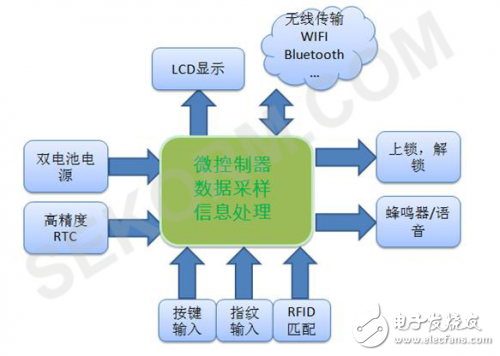With the advancement of society, science and technology and culture, the safety of mechanical locks has become increasingly unable to meet the needs of the people. At this time, smart locks came into being. It is safer and more advantageous than traditional mechanical locks. Electronic smart locks (including password locks, card locks, fingerprint locks, iris locks, etc.) are becoming more and more obvious as a new generation of recognition technology, and will gradually replace mechanical locks as the new protagonist of the lock industry.
The definition and definition of smart locks is its so-called "smart" features at the technical and functional level, including identification, memory, and learning. Smart locks in the sense of mass concept are all kinds of contact/non-contact/remote control keys/card/lock code locks, and password key locks.
Real-time clock RTC (Real_TIme Clock) plays a more important role in the smart lock application. The opening, closing, normal, abnormal and other events will generate a time-scale signal, and this time-scale signal is inseparable from RTC. The key role. The RTC provided by EPSON has the function of independently completing timing or event recording. At present, many electronic products have clock timing functions. For example, digital products such as mobile phones, notebooks, and tablet computers commonly used in daily life are integrated with a real-time clock.

Figure 1: Block diagram of the smart door lock
There are many types of RTC products, which can be classified according to package size, clock accuracy, additional functions, interface methods, standby power consumption, and the like. In the product structure, it can be divided into two types: built-in crystal and external crystal. RTC's built-in crystal structure is usually a built-in 32.768kHz crystal. The RTC external crystal oscillator is also generally a 32.768 kHz quartz crystal oscillator, and the external RTC of the crystal is low in cost, but various problems often occur. So most of the current RTC products use a built-in crystal structure. Essen's EPSON company can provide customers with RTC products with built-in 32.768kHz crystal oscillator and various interfaces and other additional functions.
RX8010SJ product features:
• Real-time clock module for low-power I2C-Bus interface:
• Built-in 32.768kHz crystal unit (frequency accuracy adjustment completed)
• Interface type: I2C-Bus interface (400kHz)
• Operating voltage range: 1.6V ~ 5.5V
• Wide timer voltage range: 1.1V ~ 5.5V
• Low standby current: 160nA / 3.0V (Typ.)
• Frequency output function: C-MOS output / open drain output
• Built-in user RAM: 128 bit (8 bit x 16, SRAM)
• Includes time, calendar, alarm, timer power, etc.
RX8130CE product features:
• Real-time clock module (I2C-Bus) built-in backup charging function:
• Built-in 32.768 kHz crystal unit (frequency accuracy adjustment completed)
• Interface type: I2C-Bus interface
• Operating voltage range: 1.6V to 5.5V
• Temperature compensation voltage: 1.1V to 5.5V
• Low standby current: 300 nA ( Typ. ) /3 V
• Power supply automatic switching function: switch to the main power supply monitor
• Backup battery charging control function: rechargeable lithium battery
• Delayed reset function: detects mains power supply and removes reset
• Different features include full calendar, alarm, timer etc.
With the rapid advancement of technology and the maturity of the day, smart locks are the most fashionable fashion trend in the 21st century, and will replace the existing locks. The market prospect is very broad.
Film Capacitor,Snubber Capacitor,Dc Link Capacitor,High Current Capacitor
XIAN STATE IMPORT & EXPORT CORP. , https://www.shvcomponents.com